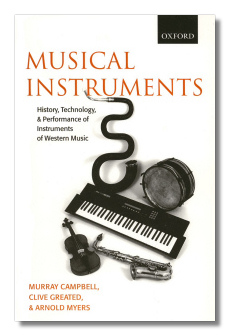
The Internet's Premier Classical Music Source
Related Links
-
Introduction
Acoustics
Ballet
Biographies
Chamber Music
Composers & Composition
Conducting
Criticism & Commentary
Discographies & CD Guides
Fiction
History
Humor
Illustrations & Photos
Instrumental
Lieder
Music Appreciation
Music Education
Music Industry
Music and the Mind
Opera
Orchestration
Reference Works
Scores
Thematic Indices
Theory & Analysis
Vocal Technique
Search Amazon
Recommended Links
Site News
 Book Review
Book Review
Musical Instruments

History, Technology and Performance of Instruments of Western Music
Donald Murray Campbell, Clive Alan Greated, Arnold Myers
Oxford University Press, USA, 2006
ISBN: 019921185X
It's tempting to say, 'There can't be too many books on musical instruments'… their history, origins and development; acoustics and sound production; place in musics from around the world; oddities and 'records'; not to mention how to play them. Indeed the field is rich with several classics and soi-disant 'definitive' volumes. But there is always room for another book on instruments – if it's well-written, covers the 'right' ground meticulously and, perhaps, exposes something new. 'Musical Instruments: History, Technology and Performance of Instruments of Western Music' by Donald Murray Campbell, Clive Alan Greated, Arnold Myers fits that bill well and can be recommended for specialists, students, researchers and general music lovers alike.
The key words, though, are definitely '…of Western Music': the authors have chosen to concentrate on instruments used in the musical traditions which use written notation. This means not only (though mainly) European and (north) American 'classical', but also ecclesiastical, civilian and military bands, dance and show music as well as jazz. Particular attention is also paid to the revival in the last half-century of 'historically inspired performance', aka 'period' instruments in 'early' music. The authors state that this decision implies no qualitative judgments about the relative merits of 'literate' as opposed to largely improvised musical traditions. So if you're looking for a single (and so necessarily selective – even at 500 pages – ) volume covering the key facts and issues in that vast field, this is worth a close look.
There are thirteen chapters, three appendices (on Pitches and Frequencies; keywork tables for typical woodwinds; brass sizes) and an unannotated bibliography for each chapter. The first two chapters deal with the nature of (musical) sound and the acoustical principles which underlie musical production. The rest look family by family (strings, woodwind, brass, percussion and electronic) at largely the same five areas. These are:
- acoustical principles
- historical development
- instrument use
- construction
- performance practice
although the flute chapter looks at Avant-Garde Techniques, the woodwind one at woodwind families and those on the clavichord, harpsichord and piano at tuning. Each chapter is about 30 pages long and divided according to these topics, so the book has a reference feel to it and can indeed be used that way; though just as much can be got from it by reading it in linear fashion since its coverage is comprehensive and authoritative.
Photographs, tables, diagrams, charts and of course musical examples abound, though are not so many as to detract from the narrational flow; this is not an encyclopedia as such. Obviously in the half-dozen or so pages devoted to, say, the performance practice of the entire woodwind family or even twice that number to the historical development of stringed instruments, distillation takes precedence over discursiveness. For anyone who's perhaps always been fascinated by how the kind of basic (and often rather drily-taught at school) principles operate in practice – just how columns of air work to our advantage and joy, for example – this conciseness is a virtue: all the main and relevant aspects of each topic are covered. Would the non-specialist really want more than the dozen pages devoted here to how an organ works?
By the time you're well into the first chapter, you realise you're in good hands. The information has been researched, where necessary, prioritised and expertly presented from the very start. You can be sure that the perspective Campbell, Greated and Myers have is sound and approached from sufficient distance to make it both useful and reliable. Of course there are some fascinating particularities and surprises… cymbals have been used in orchestral music since the 1680s; the explanations of the relative polygon shapes of clavichords, virginals and spinets make interesting ready and the way organ manuals and pedals are notated, for example. Particularly useful and illuminating in the context of a generalist survey such as this is the way historical developments are tied to composers and works: the contrasting contributions of Beethoven, Czerny, Chopin and Liszt in the section on piano styles is a good example. Generalist it is, but the exposition on the algebra of string pitches [pp 282-3] is quite specific.
So this is a survey; one of its 'selling points' is comprehensiveness and a thorough treatment of a huge field. It aims high. And succeeds very well. Essentially, you'll find almost everything you need consistent with a single-volume on the subject about any given instrument or family in this book without the taint of a 'digest' or 'potted' condensed 'crib'. The clear and accurate index is there to help you out and the bibliography to lead you where each chapter cannot go. It's not an encyclopedia, but its narrative coverage is encyclopedic. Thoroughly recommended to anyone interested in the field.
Copyright © 2007 by Mark Sealey.


















